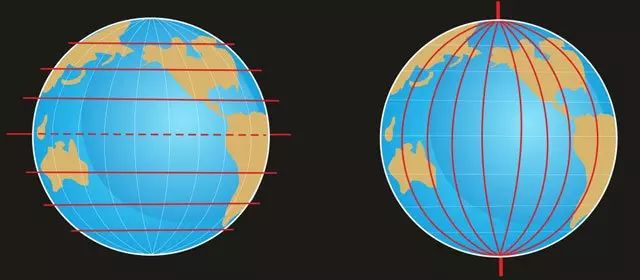The earth rotates itself from west to east (counterclockwise), at a constant speed: it makes a turn on itself every 24 hours. It spins around an invisible axis that passes through its center. The two poles (north and south) are the points where this axis (axis of the poles) crosses the terrestrial globe. The terrestrial globe evolves in a cosmos that is a priori infinite: the celestial vault or terrestrial sphere is where we can observe the stars and the movement of the planets. This celestial vault is occupied by constellations where we find the symbolic signs of our zodiac.

The hemispheres
If we imagine a division of the terrestrial globe at an equal distance from these two poles, we obtain two hemispheres. In geography, a hemisphere is a half of the globe, divided into a northern hemisphere, centered on the North Pole and a southern hemisphere centered on the South Pole. The separation between the two poles is located at the equator, perpendicular to the axis of the earth.
Most of the land is in the northern hemisphere: Europe, North America, Central America, and Northern Latin America, a large northern half of Africa and most of Asia. In the southern hemisphere, it remains the bulk of Latin America, the African countries located under the horn of Africa, Indonesia, Australia, New Zealand, and the southern continent...
The latitude
Latitude is a terrestrial measure that goes from the equator (0 °) to the poles (90 ° north or 90 ° south), the latitude is always perpendicular to the axis of the Earth. The latitudes that go from the equator to the North Pole form the northern hemisphere and the latitudes that go from the equator to the South Pole form the southern hemisphere. The points which lie under the same latitude form an approximate circle called the parallel. The further away from the equator, the narrower the parallel, and at the poles (north and south) this line is reduced to one point.
The longitude
Longitude is an earthly measurement that indicates the east or west position of a point in the world relative to the meridian of Greenwich.This meridian is an imaginary line that goes from one pole to another, unlike the latitude (North or South position) which benefits from the equator and the poles as references, no natural reference exists for the longitude. The reference meridian has therefore been determined by default: the Greenwich meridian (which also serves as a reference for time zones) is the 0 ° of longitudes. They then spread eastwards from 0 to -180 ° and westwards from 0 to + 180 °.
The position of the planets in the celestial vault, therefore, depends on the location (latitude and longitude) and the complete date, including the time to accurately determine the longitude.
The constellations
A constellation is a group of stars in the sky. By connecting the stars that compose it, we obtain a "drawing" that gives it its name. The International Astronomical Union (IAU) divides the sky into 88 official constellations, with precise boundaries, so that each point of the sky belongs to a constellation. In astrology, 12 of these constellations are named after the twelve signs of the zodiac.
However, this zodiac is different from the astronomical zodiac observed today: with the phenomenon of the precession of the equinoxes, our current sky is different from the sky that has been the basis of traditional astrology. The precession of the equinoxes is a slow change of direction of the axis of rotation of the Earth which, over time "displaces" the constellations.
If you are passionate about this debate, here is a full explanation: Precession Equinoxes Debate






